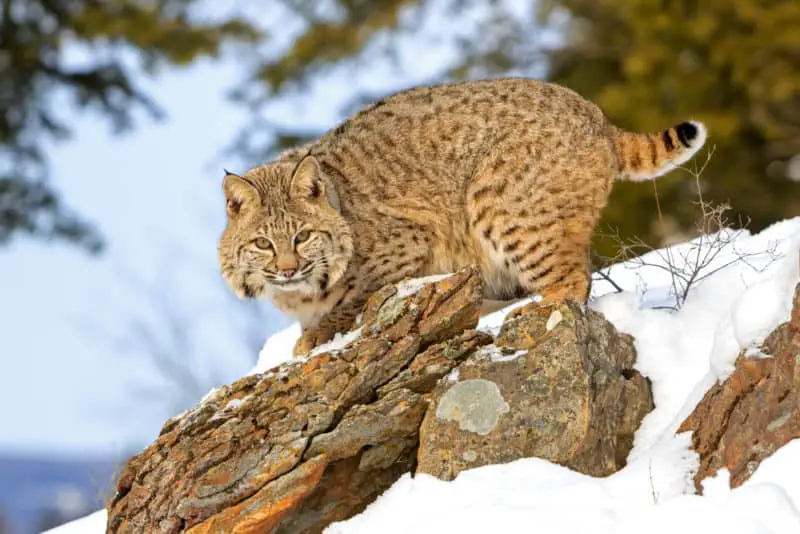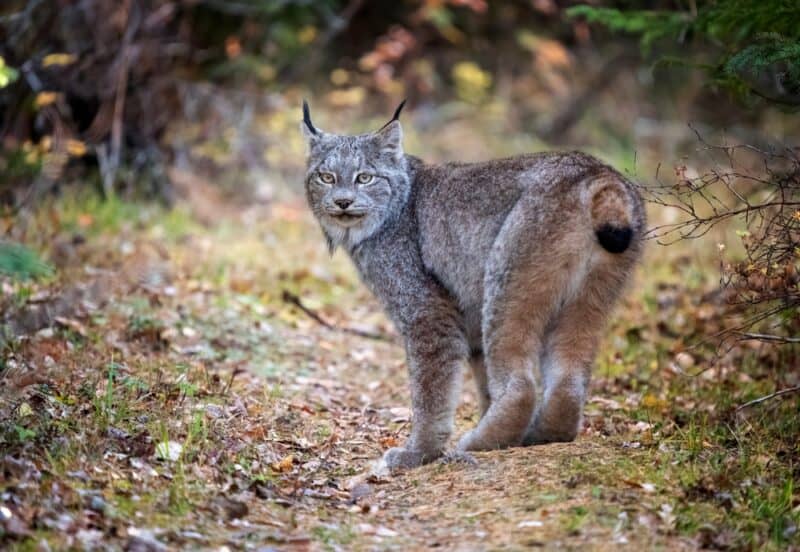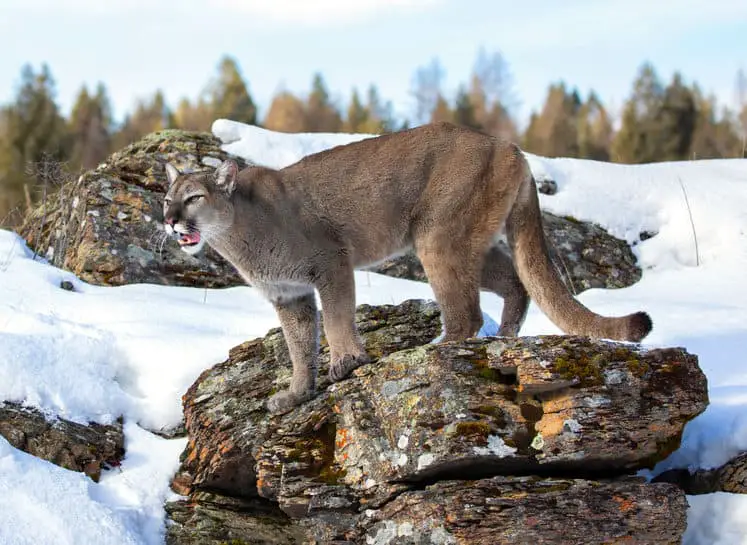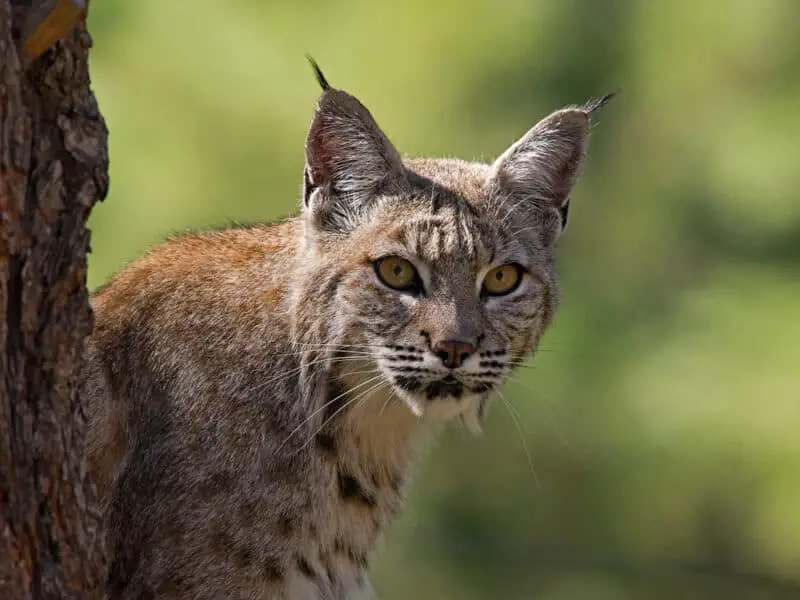New Hampshire has 2 native wild cat species living within the state. They are the bobcat (Lynx rufus) and the Canada lynx (Lynx canadensis). There are numerous mountain lion sightings reported in the state. However, according to the New Hampshire Fish and Game Department website, “there is no physical evidence of mountain lions within the state”. Furthermore, the eastern mountain lion, which is the sub-species that used to inhabit New Hampshire, became extinct in 1938. See
Bobcats in New Hampshire (Lynx rufus)
The bobcat is the official state wildcat of New Hampshire. This cat, which is also known as the Red lynx or the Bay lynx, is a North American wild cat. Biologists believe that both the bobcat and the Canada lynx are descendants of the Eurasian lynx whose ancestors crossed into North America via the Bearing Sea land bridge.
According to a New Hampshire Fish and Game and the University of New Hampshire survey, there are around 1400 bobcats living in the state.
Where do bobcats live?
Bobcats reside only in North America. Their range begins in southern Canada and then extends south through most of the United States and down into central Mexico.
In New Hampshire, bobcats live in most areas of the state. People rarely see them, though, because they are mostly nocturnal or crepuscular animals.
Compared to Canada lynx, which thrive in deep snow country, bobcats struggle more in the snow due to the fact that they cannot walk on top of it like lynx can. A lynx’s oversized feet function like snowshoes keeping it on the snow’s surface. On the other hand, compared to lynx, bobcats have small feet that tend to sink into the snow. If the snow is too deep and powdery, it reduces their mobility along with their ability to catch prey.
Other than their inability to cope with deep snow, bobcats are pretty versatile and tend to utilize all the different habitats within their range. You can find bobcat populations anywhere, from areas with coniferous forests to swamps and semi-forested mountain areas. You’ll even find them in agricultural areas and or urban areas.
The sizes of home ranges for bobcats in New Hampshire differ between males and females. According to data from the Squam Lakes Natural Science Center, adult males utilize around 36 square miles. On the other hand, adult females need around 12 square miles.
Bobcats often use rock crevices as den sites but may also den in the cavity beneath an overturned stump or beneath a blown-down tree,

What do bobcats look like?
Adult bobcats are slightly smaller than adult Canada lynx.
A bobcat is 2 to 3 feet long and weighs about 15 to 35 pounds. Adult male bobcats are quite a bit larger than females.
These animals have a “bobbed,” short tail with black bands on their upper surface. Their tail also has a black tip on its upper surface but not the back. Their fur is usually gray to brown, with mottled dark spots interspersed with black lines on their bodies. They also have black stripes on their inner forelegs and tail.
From a side view, you will notice that a bobcat is slightly higher at the rump than at the shoulders. Bobcats and lynx have long hind legs in proportion to their forelegs.
Bobcats have black-tufted, proportionately large ears. In other words, they have short ear tufts of hair that poke up above their ears and are black at the tips. The backs of their ears, below the black tips, are black. In the center of the black of each ear, they have a single white spot. This gives the impression of a false eye on the back of each ear.
They also have a whiskered face that seems broader due to their long ruffled facial hair and whiskers. Their eyes are yellow with round black pupils.
In 2020, film footage of a rare black bobcat was taken near Danville, Vermont. See
These melanistic bobcats have all the markings that non-melanistic ones do. They manifest as darker black spots on top of lighter black or dark grey.
What do bobcats eat?
Despite their comparatively small size, bobcats are aggressive, tough predators. At times, particularly during the winter, they take down relatively larger prey such as deer. However, their regular diets mainly consist of small prey such as small mammals, reptiles, birds, and carrion. When they take up residence close to a residential area, their menu might occasionally also include small pets.
They even prey on venomous snakes when the opportunity arises despite not being immune to the venom. They accomplish this by using their quickness to pin the snake’s head down with a paw, after which they dispatch the snake with a quick bite to its spine behind the head. New Hampshire has only has one species of venomous snake, and that is the timber rattler. See
Reproduction and Life Cycle for Bobcats in New Hampshire
Bobcats mate anywhere in February and March. During the breeding season, a male bobcat may mate with multiple females. If they successfully mate, the gestation period for bobcats is 60 days.
After breeding, the male and female go their separate ways. The female takes all responsibility for the selection of a den site and the rearing of the young. Females generally give birth between late April and early May. See
In New England, the average bobcat litter size is 3 kittens. Bobcat kittens are born with their eyes sealed, just like domestic cats are. However, their eyes will open when they are a week to 10 days old. By the time they are 2 months old, they will have replaced their spotted baby fur with a haircoat similar to what their parents have.
By mid-July, the kittens begin to venture out with their mothers to fine-tune their survival skills. Their training may last into the early winter. By mid-winter, the kittens strike out on their own.
Female bobcats reach sexual maturity at 1 year of age, while males reach sexual maturity at age 2.
In the wild, the average life span of a bobcat is 7 to 10 years. See

Canada Lynx in New Hampshire (Lynx canadensis)
New Hampshire is 1 of three New England states that have Canada lynx. The other 2 are Maine and Vermont
The U.S. Fish and Wildlife Service listed the Canada lynx in the contiguous United States as threatened under the Federal Endangered Species Act.
Where do Canada lynx live?
Canada lynx favor the boreal forest in the mountainous regions of Canada, the northern United States, and the southern Rockies. The U.S. states that have Canada lynx are Alaska, Colorado, Washington, Idaho, Montana, Minnesota, Wisconsin, Vermont, Michigan, New Hampshire, and Maine.
In New Hampshire, the most consistent area of lynx habitation is in Pittsburg along the Maine and Canadian border. The town of Pittsburg is in northern Coos County, New Hampshire. It takes in an area of 291.3 square miles and yet only had a population of 800 in the 2020 U.S. census.
In 2011, 4 Canada lynx kittens were discovered in northern Pittsburg. This was taken as evidence of a breeding population within the state of New Hampshire.
The habitats with the highest likelihood of Canada lynx are in Pittsburg within the Connecticut Lakes Natural Area and within the White Mountain National Forest. See
Canada Lynx Characteristics
What does a Canadian lynx look like? Canada Lynx are beautiful animals. They share a lot of physical similarities with their close relative, the bobcat. But the two also share some differences. First of all, lynx are slightly larger than bobcats. Adult lynx are up to 35 1/2 inches (90 cm) long and 26 inches (65 cm) tall. Additionally, they weigh up to 37 and a half pounds (17 kg).
Lynx have stubby tails. While the tail of a bobcat is short or “bobbed,” a lynx’s tail is shorter still. They don’t have the black bands on the top side of their tails that bobcats have. However, they do have a completely black-tipped tail. The black tip on a lynx’s tail surrounds the entirety of the tail as if the tail had been dipped in black paint. On the other hand, a bobcat’s black tip is only on the top side of the tail.
Canada Lynx have long, thick grey fur in the winter. By summertime, they have shed their grey fur and have a thinner, shorter reddish-brown fur coat instead. Their color is more uniform than that of bobcats. While bobcats have black spots and mottled coloration over their entire body, Lynx are solid tan except for some mottled darker brown spots on their legs.
Canadian Lynx have triangular pointed ears with black backs and long tufts of black hair on the tips. The hair tufts are much longer than a bobcat’s. They also have drooping flared facial ruff of white hair on the sides of their face beneath their chin.
Their eyes are green with round black pupils.
Lynx have long legs in proportion to their bodies. Interestingly, they have slightly longer legs in the rear than in the front. This gives their body a peculiar, downhill-sloped appearance.
Canadian Lynx have evolved to prey on snowshoe hares. They have almost comical-looking oversized fur-covered paws. They put their larger feet to good use. Their large paws function like snowshoes, allowing them to travel and hunt on top of the snow. Canadian lynx feet can keep almost twice as much weight from sinking into the snow as those of a bobcat. This is why they range over the deep snow country of northern Canada while bobcats do not.
Reproductive Behavior and Life Cycle for Canadian Lynx
Breeding season for the Canadian Lynx begins in late February and goes to early April. Lynx females are mono estrus, meaning they have one estrus cycle per year. Females mate with only one male and are in heat from 1 to 10 days. On the other hand, males may mate with multiple females.
Reproduction in Canadian Lynx is directly affected by the abundance or lack of their prey animals. If they successfully mate, their gestation period lasts 56 to 70 days.
The pregnant female will typically make a maternal den beneath rock ledges, a fallen log, in the root tangle of a fallen log, or a thick tangle of brush.
Lynx kittens are sightless for the first two weeks of their life. By the time they’re 5 weeks old, they’ll be big enough to leave the den. Their mothers wean them when they’re around 10 weeks old, and at 10 months, they’ll go out on their own. Source
Female Lynx are sexually mature at 10 months old, but they generally don’t come into heat for at least another year. However, in periods of prey abundance, yearling females will breed and give birth.
Male Lynx reaches maturity at around 33 months of age.
The lifespan of a Canadian lynx is somewhere between 10 and 20 years in the wild. They can live over 20 years in captivity. See
What do Canada Lynx eat?
Mice, squirrels, ptarmigans, grouse, ducks, deer, Dall sheep, and caribou make up a portion of a Canadian lynx’s diet in regions where these prey animals are available. However, over most of their range, their preferred food is snowshoe hares.
Lynx and Snowshoe Hare
The Canada lynx is very dependent on snowshoe hares as a food source. In some areas, hares comprise 75% of their total diet. In fact, their population density is directly correlated with the snowshoe hare population.
Canadian and Alaskan Canadian Lynx and snowshoe hares go through what is known as the Lynx-Snowshoe Hare Cycle. When food sources are abundant for hares, their population increases very rapidly since they can have several litters per year. When hare populations are at their peak, there can be as many as 1500 animals per square kilometer (3913 per square mile). At this time, the population of Lynx and other predators are also at their peaks.
Are there mountain lions in New Hampshire? (Puma concolor)
According to wildlife biologists with New Hampshire’s Fish and Game Department, there is no evidence to support the notion that there is a breeding mountain lion population within the state. However, they encourage New Hampshire residents to report any mountain lion sightings or come forward with any DNA evidence.
Mountain lions were expatriated from the New England states by the late 1800s. The last mountain lion killed by a hunter in New Hampshire was in 1885.
So far, the photographic evidence that has been brought forward in recent years are pictures of misidentified bobcats or, occasionally, a house cat. There have even been photos of cougars taken in states other than New Hampshire that people have pulled from the internet.
Any DNA samples that people have turned in, such as hair samples or scat, have also turned out to be from animals other than mountain lions so far.
The eastern cougar that supposedly once inhabited New Hampshire was declared extinct by the U.S. Fish and Wildlife Service in 2011. However, the eastern cougar probably never existed taxonomically as a separate subspecies of cougar. The 2017 Cat Classification Task Force determined that the DNA evidence only supports the existence of 2 mountain lion sub-species, 1 for North and Central America and 1 for South America.
The only known mountain lion that currently inhabits the eastern states is the Florida panther.

What do mountain lions look like?
You might be wondering what mountain lions look like with all the cougar sightings being reported out there.
The mountain lion is a large cat that is native to North America, Central America, and South America. To visualize what a mountain lion looks like, picture a giant house cat with short tan hair. Mountain lions are much larger than domestic cats, though. An average house cat weighs around 10 pounds, while male mountain lions can weigh over 200 pounds.
These animals have lean, muscular bodies, rounded heads, and upright ears that are oval at the tip. Another characteristic of the mountain lion is its thick long tail, which accounts for almost one-third of its entire length. Their long tail helps them keep balanced as they navigate through uneven terrain.
Mountain lions have a light brown coat of short, coarse hair over most of their body. The area around their nose, the tip of their tail, and the tips of their ears are black. Their belly, the area above their upper lip, below their lower lip, and their chin are all white. They also have a sprinkling of dark hair on their backs. There are some coat color variances between different geographic locations.
Transient Mountain Lions From Western States
Transient cougars have been known to travel huge distances from the breeding population that they originated from. These big cats are territorial. Mountain lions patrol and use scent markings to post their territories, which are up to 100 square miles. What’s more, male mountain lions fight to the death sometimes to settle territorial disputes.
Getting back to transient mountain lions, sometimes sub-adults travel great distances in search of a new home range. In 1 documented case, back in 2011, a young male traveled over 1,500 miles from South Dakota to be struck by a car and killed in Connecticut.
So, could there be mountain lions in the Granite State? The answer is yes, but if you see one, it might just be passing through the state.
You might also like
Wild Cats in Vermont – Krebs Creek
Wild Cats in Maine – Krebs Creek
Recent Posts
The only venomous snakes in Washington State are Northern Pacific Rattlesnakes. The Northern Pacific Rattlesnake (Crotalus oreganus oreganus) is a sub-species of the Western Rattlesnake. Anyone...
Skunks are not classified as true hibernators. But they go into a state of torpor when the weather gets cold. Skunks are light sleep hibernators, along with opossums, bears, and raccoons. ...

